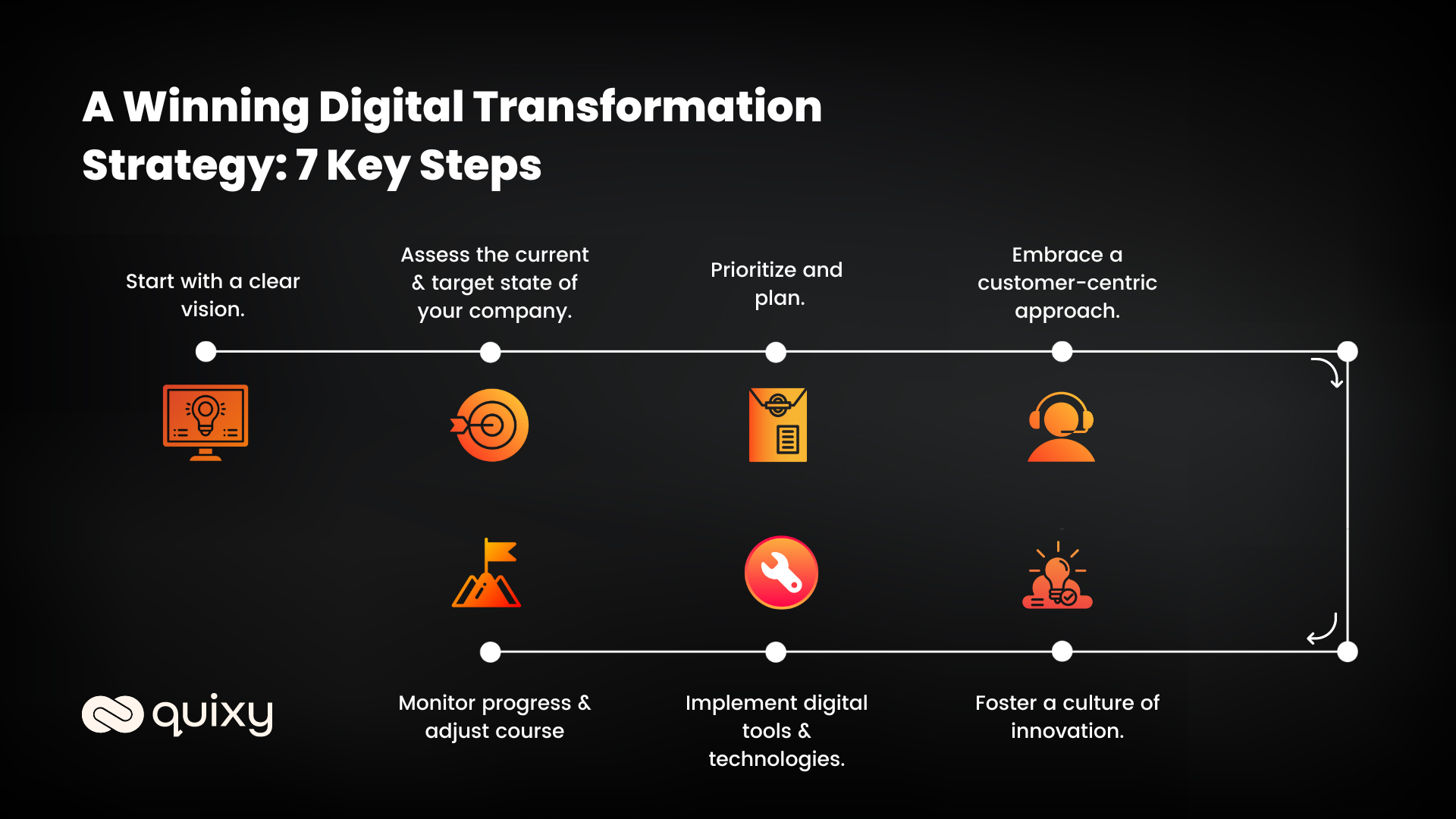
Digitally transformed businesses are anticipated to contribute $53.3 trillion to GDP, which is more than half of the Global GDP. However, only 53% of businesses have a digital transformation strategy that is applied across the board.
The rest 47% of businesses are surrounded by the following pain points, which ultimately become a constraint in creating a digital transformation framework:
- Lack of a solid plan.
- Too many employees have access to data and information.
- Hardware and software issues.
- Poor judgment of online safety.
- No mobile device action plan.
- No data backup or backup issues.
- The downfall of old technology.
- Lack of professional or qualified experience.
- Poor or non-extensive network security.
This blog will walk you through the 7 key components of creating an impactful digital transformation strategy. These components will help you win the perks of a digital transformation framework and solve your business’s known and unknown pain points.
We have also incorporated digital transformation examples and statistics across the industries from a real-life perspective. Read on!
What is a Digital Transformation Strategy?
A digital transformation strategy is a course of action for an organization to use technology to change how it operates and delivers value to customers fundamentally. It involves rethinking business processes, customer experience, and the use of data and technology. The goal is to improve efficiency, effectiveness, and competitiveness in the digital age.
A successful digital transformation strategy involves a holistic approach that considers the company’s culture, structure, and resources.
Also Read: From Paper to Digital: 9 Simple Steps for a Successful Digital Procurement Strategy
The Importance of a Digital Transformation Strategy
A digital transformation strategy is a roadmap that outlines how an organization will leverage digital technologies to achieve its business goals. It’s essential for businesses of all sizes to stay competitive in today’s rapidly evolving digital landscape.
Here’s why a digital transformation strategy is crucial:
1. Enhanced Customer Experience
- Personalized interactions: Understanding customer behavior through data allows for tailored experiences.
- Improved customer service: Digital channels can provide faster, more efficient support.
- New revenue streams: Digital platforms can create opportunities for additional offerings.
2. Operational Efficiency
- Automation: Streamlining processes reduces manual tasks and errors.
- Data-driven decisions: Insights from data can optimize operations and resource allocation.
- Cost reduction: Digital tools can help lower operational expenses.
Also Read : eMudhra Signer Gateway in Quixy: For Secure & Effortless Digital Signatures.
3. Innovation and Growth
- New business models: Digital transformation can open up new markets and revenue streams.
- Product development: Digital technologies can accelerate product development and time-to-market.
- Competitive advantage: Staying ahead of the curve can position a business as a market leader.
4. Risk Mitigation
- Cybersecurity: A strong digital strategy includes robust security measures to protect data.
- Business continuity: Digital systems can help maintain operations during disruptions.
- Compliance: Digital tools can help ensure adherence to regulations.
5. Employee Engagement and Productivity
- Empowerment: Digital tools can provide employees with the resources to work more efficiently.
- Collaboration: Digital platforms can foster teamwork and knowledge sharing.
- Talent acquisition: A strong digital presence can attract top talent.
In essence, a digital transformation strategy is not just about technology; it’s about rethinking business processes, customer interactions, and organizational culture to create a sustainable competitive advantage.
Why the Enterprise Needs a Digital Transformation Strategy
In today’s rapidly evolving market, enterprises can no longer afford to rely on outdated systems and siloed thinking. A well-defined digital transformation strategy acts as a north star that aligns innovation efforts with business value.
Here’s why every enterprise needs one:
✅ Stay Competitive
Digital-first competitors are faster, leaner, and more customer-focused. A strategy ensures you stay relevant and ahead of disruption.
✅ Enable Agility
A strategic roadmap allows organizations to respond swiftly to market changes, customer needs, and global shifts like remote work or supply chain disruptions.
✅ Improve Customer Experience
Digital tools enable personalized, consistent, and seamless experiences across channels. A strategy ensures customer experience is central to your transformation journey.
✅ Break Down Silos
A cohesive strategy fosters collaboration across departments, aligning goals and driving integrated digital initiatives.
✅ Maximize ROI
Without a strategy, tech investments can be fragmented and underutilized. A clear approach helps prioritize the right platforms, avoid waste, and track measurable outcomes.
✅ Build a Culture of Innovation
Transformation is as much about mindset as it is about tools. A strategic framework helps create a culture where experimentation, learning, and improvement are continuous.
✅ Future-Proof the Business
With the right strategy, businesses can evolve alongside technology, enabling continuous growth and long-term resilience.
Also Read: Digital Transformation in Insurance
Key Trends in Digital Transformation in 2025
Digital transformation is a dynamic field, but based on current trajectories, here are some key trends expected to shape 2025:
1. AI-First Everything
AI is no longer an add-on—it’s the foundation. From intelligent automation and decision support to generative AI tools enhancing content, code, and customer service, businesses are weaving AI deeply into their operations.
Trend Tip: Companies are adopting AI agents and copilots to boost productivity and creativity at scale.
2. Low-Code No-Code Goes Mainstream
Low-code No-code app development platforms are empowering business users and developers alike to build apps, automate workflows, and integrate systems with minimal effort. This trend supports faster innovation and reduces tech backlog.
Trend Tip: Fusion teams—cross-functional groups of developers and business users—are on the rise to drive agile digital initiatives.
3. Hyperautomation
Beyond just RPA, hyperautomation layers AI, machine learning, and event-driven architecture to automate complex, end-to-end business processes.
Trend Tip: Organizations are moving toward full-stack automation, not just task-level fixes.
4. Composable Architecture
Organizations are shifting away from monolithic IT systems to modular, “composable” architectures. This allows greater agility, reusability, and adaptability when responding to change.
Trend Tip: Think of technology as building blocks—swap, scale, or rebuild without starting from scratch.
5. Cloud-First, Cloud-Smart
Cloud transformation has matured from “lift and shift” to “optimize and innovate.” Companies are now balancing multi-cloud and hybrid-cloud strategies with a focus on cost, security, and flexibility.
Trend Tip: Edge computing is gaining traction to reduce latency and bring real-time data processing closer to users.
6. Digital Trust and Cybersecurity
With data breaches and AI-generated threats on the rise, cybersecurity is evolving fast. Zero Trust architecture, privacy-enhancing tech, and identity-first security are becoming non-negotiables.
Trend Tip: Security is shifting left—baked into apps and processes from the start.
7. Data-Driven Everything
Organizations are turning to data as a core strategic asset. From real-time dashboards to predictive analytics, businesses are making faster, smarter decisions.
Trend Tip: AI-powered data ops (DataOps) are becoming essential to handle the complexity of modern data pipelines.
8. Sustainable Tech Transformation
Green IT and sustainable software development are no longer just good PR—they’re becoming mandates. Digital transformation now considers environmental impact in strategy and design.
Trend Tip: Cloud optimization, serverless architecture, and LCNC can help reduce energy consumption and tech waste.
9. Personalized Digital Experiences
From B2C to B2B, customers and employees expect seamless, personalized, omnichannel interactions. Organizations are turning to DXPs, AI, and analytics to deliver meaningful experiences at scale.
Trend Tip: Personalization is no longer about first names in emails—it’s about context, behavior, and intent.
10. Tech-Driven Employee Experience (EX)
Empowering remote and hybrid teams with the right tools, dashboards, automation, and collaboration platforms is central to digital transformation today.
Trend Tip: A happy workforce is a digital-ready workforce. Tech that supports well-being, productivity, and personalization will thrive.
Important Factors to Consider When Making a Digital Transformation Roadmap
Digital transformation is more than just adopting the latest technologies—it’s about creating a unified strategy that aligns people, processes, and platforms to drive lasting value.
Here are the 10 critical factors to include when building a practical and future-ready digital transformation roadmap:
1. 🎯 Clear Business Objectives
Start with the why. Identify what you want to achieve—whether it’s enhancing customer experience, improving operational efficiency, enabling remote collaboration, or speeding up innovation.
✅ Align digital initiatives with measurable business outcomes.
2. 🧭 Leadership & Stakeholder Alignment
Transformation requires top-down commitment. Ensure executives, department heads, and key users are aligned and engaged.
✅ Appoint transformation champions and establish cross-functional teams.
3. 🔍 Current State Assessment
Understand where you are today. Evaluate IT infrastructure, digital maturity, workflows, and employee capabilities to uncover gaps and opportunities.
✅ Use digital maturity models or SWOT analysis to assess readiness.
4. 👥 Customer-Centric Mindset
Put your customers at the core. Ensure the transformation enhances value across the customer journey, not just internal processes.
✅ Map user journeys and gather continuous feedback.
5. 🧱 Scalable & Flexible Technology Stack
Adopt modular, cloud-native, API-first platforms that can evolve with your business needs and integrate easily with existing systems.
✅ Avoid vendor lock-in and prioritize interoperability.
6. 📊 Data Strategy & Governance
Establish how data will be collected, managed, protected, and used. Ensure a single source of truth across the organization.
✅ Create a data-driven culture with robust governance and compliance.
7. 📚 Change Management & Training
Empower your workforce with training, tools, and transparent communication to reduce resistance and accelerate adoption.
✅ Foster a learning culture with role-specific upskilling programs.
8. 🔁 Agile, Iterative Execution
Break down the roadmap into small, manageable phases. Learn fast, adapt quickly, and scale what works.
✅ Adopt agile frameworks to stay flexible and responsive.
9. 💰 Budgeting & ROI Tracking
Develop a realistic investment plan and track returns holistically—think beyond cost savings to include productivity and satisfaction.
✅ Factor in long-term gains from automation and optimization.
10. 🚀 Continuous Innovation
A transformation roadmap should never be static. Revisit and refine it as technology and business needs evolve.
✅ Schedule quarterly reviews to stay ahead of the curve.
Also Read: The Real Challenges of Digital Transformation to Overcome this year
The 4Ps of Digital Transformation: Platform, People, Projects, and Processes
Digital transformation isn’t just about technology adoption—it’s about orchestrating change across the entire organization. The 4Ps framework—Platform, People, Projects, and Processes—offers a clear, strategic lens through which enterprises can plan and execute successful digital initiatives.
1. 🖥️ Platform
The platform is the technology foundation that powers digital transformation. This includes cloud infrastructure, low-code/no-code platforms, automation tools, data lakes, and enterprise software.
📌 Goal: Build a scalable, secure, and interoperable digital foundation that supports innovation, agility, and growth.
2. 👥 People
People are the heart of transformation. Without workforce engagement, upskilling, and leadership support, even the best technology will fall short.
📌 Goal: Empower employees at all levels to adopt, adapt to, and thrive with new digital capabilities through training, change management, and cultural alignment.
3. 🚀 Projects
Projects are the vehicles for execution. From automating tasks to launching new digital products, well-defined and strategically aligned projects turn transformation goals into reality.
📌 Goal: Focus on high-impact, agile projects that align with business objectives and deliver measurable results quickly.
4. 🔄 Processes
Efficient processes are what tie everything together. Digitizing and optimizing workflows not only boosts efficiency but also enhances consistency, scalability, and user experience.
📌 Goal: Reimagine and streamline legacy processes for speed, resilience, and customer-centricity.
Together, these four pillars create a holistic digital transformation strategy—one that doesn’t just implement technology, but enables true enterprise-wide evolution.
How to Build a Winning Digital Transformation Strategy: 7 Key Steps
Digital transformation is one of the necessities for businesses to stay competitive and relevant in today’s fast-paced and technology-driven world. However, building a successful digital transformation strategy requires careful planning and execution.

Learn how to create a winning digital transformation strategy in 7 steps!
Step 1. Start with a clear vision
Starting with a clear vision is indeed the first step in creating a digital transformation strategy. The vision should define the desired future state and guide the organization as it embarks on its digital transformation journey. It should articulate the organization’s purpose, values, and aspirations in the digital era and provide a roadmap for how technology can help acquire these goals.
Having a clear vision sets the direction and provides focus, ensuring that all efforts are aligned and moving towards a common goal.
Step 2. Assess the current and target state of your company
Current state
Assessing your company’s current state is the second step in creating a digital transformation strategy. It involves evaluating your current technology, processes, and systems to identify areas of improvement and determine how well-equipped you are to achieve your digital transformation goals.
This step is crucial because it provides a baseline for where you are now and helps you prioritize the areas that need attention and investment to enable your transformation journey. It may involve conducting a technology audit, analyzing data, and talking to employees and stakeholders to understand their perspectives and experiences.
Target state
While creating a digital transformation strategy, define the target state. This involves setting clear and measurable goals for what the organization wants to achieve through digital transformation and the desired end state.
This helps to ensure that everyone is working towards a common vision and provides a roadmap for how to get there. The target state should align with the overall business strategy and consider current and future trends in technology and the marketplace.
Step 3. Prioritize and plan
After assessing the current state and defining the objectives, the fourth step in creating a digital transformation strategy is prioritizing and planning the initiatives to help achieve those objectives. This involves prioritizing the initiatives based on their impact and feasibility and then creating a roadmap and timeline for implementation.
The goal is to ensure that the initiatives are aligned with the overall digital transformation strategy and that resources are allocated appropriately to ensure successful implementation.
Step 4. Embrace a customer-centric approach
Embracing a customer-centric approach is essential in creating a digital transformation strategy. This means putting the needs and wants of your customers at the forefront of all decision-making and using technology and data to create personalized and seamless experiences for them. Organizations can increase customer satisfaction and loyalty by putting the customer first, ultimately driving growth and success.
HBR asserts that customers will always favor straightforward solutions over cumbersome ones, particularly in the current generation, which has access to many possibilities. Therefore, businesses that don’t concentrate on making things simpler for their clients risk losing those customers.
Step 5. Foster a culture of innovation
Fostering a culture of innovation is crucial in creating a digital transformation strategy. This involves encouraging and empowering employees to think creatively and experiment with new technologies, processes, and working methods.
By creating an environment where innovation is valued and encouraged, organizations can foster a culture that drives continuous improvement and helps them stay ahead in a rapidly changing digital landscape.
Here are the two parts of technology and innovation:
Process optimization
The digital transformation strategy must guarantee business process optimization while achieving the objectives established for both the internal team and the target audience. The digital transformation strategy must include every related business process to maximize output.
You must effectively utilize your collected data in addition to optimizing company processes.
Curation of data
When developing transformation initiatives, people frequently choose their chosen technology before examining their data. This is not how it ought to operate. Without data analysis, you may be aware of the gaps your internal team needs to close, but you risk omitting the ones your consumers frequently encounter.
Your team can discover the best solutions to issues through data analysis and dissemination of its findings, which will help you create a better digital transformation framework and make the most of the transformation process.
Step 6. Implement digital tools and technologies
Your digital transformation strategy must include several cutting-edge technologies, including the following:
Distributed and Cloud platforms
According to Gartner, Inc., enterprise IT spending on public cloud computing will surpass investment in traditional IT in various market segments by 2025.
The moment has come to step up to NoOps, which is accomplished through extreme automation throughout your SDLC.
Additionally, businesses are adopting technology solutions based on API and therefore making strategic decisions.
Artificial Intelligence and Data Analytics
Any digital transformation strategy has placed data at the forefront because it enables us to deal with facts rather than preconceptions. These tools and techniques assist organizations in transforming growing data volumes into a future-ready foundation for a new era in which machines will supplement human decision-making and make real-time and at-scale decisions that humans cannot remain nimble. ML is promising to overhaul enterprise decision-making and operations.
A strong AI engineering approach supports AI models’ scalability, performance, interpretability, and reliability while providing the full benefit of AI investments by using the main AI engineering pillars of DataOps, ModelOps, MLOps, and DevOps.
Digital Reality and Digital Experience
The redesign of digital business moments, automated operational tasks, new business models, and, last but not least, new goods, services, and channels will all be made possible by intelligently composed businesses.
Organizations are maximizing individual and team performances and customizing the customer experience through personalized suggestions by using the power of these next-generation interfaces, smart displays that are enhanced with intelligent algorithms, and IoT technologies.
Step 7. Monitor progress and adjust course
Monitoring progress and adjusting the course is essential in creating a successful digital transformation strategy. Regularly evaluating the results of the strategy implementation helps identify areas that need improvement and make necessary adjustments. This ensures that the organization stays on track to achieve its digital transformation goals and remains competitive in the digital landscape.

Also Read: Top 10 Benefits of Digital Transformation for the Redefined Future
Who should be involved in creating a digital transformation strategy?
The Asia-Pacific Digital Transformation Report highlights the urgent need for policymakers and stakeholders to coordinate policies and activities for digital transformation while keeping an eye on how the digital transformation environment is developing at the regional and national levels.
Key players that should be involved in creating a digital transformation strategy include
- Senior executives: Senior executives provide the vision and leadership for the digital transformation initiative.
- IT leaders: They assess the technology requirements and recommend solutions supporting the strategy.
- Business leaders: They determine the business objectives for the digital transformation & how it will impact their areas of the organization.
- End-users: They provide insights into how digital technology can improve their daily work processes and experience.
- External experts: They provide industry-specific knowledge and bring a fresh perspective to the process.
Digital Transformation Examples Across Different Industries
Here are a few examples of digital transformation in various industries:
Healthcare: The use of electronic health records (EHRs) and telemedicine allows remote patient monitoring and virtual consultations.
Retail: The implementation of omnichannel retail experiences, where customers can shop seamlessly across physical stores, online marketplaces, and mobile devices.
Financial Services: The adoption of digital-only banking and the use of robot advisors for investment management.
Manufacturing: Integrating the Internet of Things (IoT) and data analytics to optimize production processes and supply chains.
Transportation: The development of autonomous vehicles and the use of data to optimize transportation networks and improve safety.
Education: Online learning platforms and virtual classrooms make education more accessible and convenient.
Also Read: How Quixy Can Help You with Digital Transformation?
How to Measure ROI of Digital Transformation Initiative
The table highlights key performance indicators across financial, operational, and customer domains, providing a comprehensive framework for evaluating business performance. By focusing on these metrics, organizations can identify opportunities for increased revenue, cost reduction, and enhanced customer satisfaction. Understanding and optimizing these metrics is essential for strategic decision-making and achieving long-term business objectives.
| Category | Metric | Description |
|---|---|---|
| Financial | Revenue growth | Increased sales due to new digital channels or products. |
| Cost reduction | Savings from automation, process optimization, or reduced operational expenses. | |
| Profit margin improvement | Enhanced profitability through increased revenue or reduced costs. | |
| Return on investment (ROI) | The overall financial return on digital transformation initiatives. | |
| Operational | Efficiency gains | Increased productivity and reduced cycle times. |
| Error reduction | Lower rates of mistakes or defects. | |
| Resource optimization | Improved utilization of personnel and assets. | |
| Time-to-market | Faster product or service delivery. | |
| Customer | Customer satisfaction | Improved customer experiences and ratings. |
| Customer retention | Increased loyalty and reduced churn. | |
| Customer acquisition cost (CAC) reduction | Lower costs for acquiring new customers. | |
| Customer lifetime value (CLTV) increase | Higher revenue generated from existing customers. |
Conclusion: Embracing Digital Transformation for Business Success
To sum up, the 7 key components of the digital transformation strategy define the desired outcome of the transformation and align it with the overall business strategy. Conduct a thorough analysis of the organization’s current technology, processes, and culture to identify areas for improvement. Clearly articulate the organization’s desired state, including the technology and processes to be adopted and the desired customer experience.
Based on the target state, prioritize the initiatives and develop a roadmap to guide the digital transformation. Ensure that the customer is at the user of the transformation and that the changes being made will improve the customer experience. Encourage a culture that supports innovation, creativity, and continuous improvement. And lastly, continuously measure progress, adjust the plan as needed, and ensure that the transformation stays aligned with the digital business strategy.
Frequently Asked Questions(FAQs)
Q. Why does Digital transformation strategy matter for businesses?
A digital transformation strategy outlines a comprehensive plan that integrates technology across an organization, aiming to enhance operations, improve customer experiences, and drive innovation. It matters for businesses as it enables adaptation to evolving market trends, boosts efficiency, and ensures competitiveness in a digital-first world. A well-defined strategy aligns technological advancements with business goals, fostering growth, resilience, and the ability to meet evolving customer demands in today’s dynamic business environment.
Q. Why are adaptability and agility essential in digital transformation strategies?
They enable organizations to swiftly respond to evolving market demands, technological advancements, and customer preferences. By being adaptable, businesses can pivot strategies, embrace innovation, and seamlessly integrate new technologies. Agility fosters the ability to navigate uncertainties, enabling quicker decision-making, rapid implementation of changes, and maintaining a competitive edge in dynamic markets during the digital transformation journey.
Q. How does a customer-focused approach impact DT strategies?
A customer-focused approach significantly impacts digital transformation strategies by prioritizing the customer’s needs, preferences, and experiences. By centering efforts around customers, businesses can tailor products, services, and processes to meet their expectations effectively. This approach drives innovation, enhances customer satisfaction, and fosters loyalty. It also guides the development of personalized experiences, refining engagement strategies, and ultimately, amplifying business success in a digitally transformed landscape.
Q. How do leadership commitment and vision impact digital transformation?
Leadership commitment and vision play pivotal roles in driving successful digital transformations. Leaders who are committed to the transformation process inspire and guide their teams through change. Their vision sets the direction, fostering a clear understanding of goals and objectives. This commitment instills confidence, motivates employees, and ensures alignment across the organization. Strong leadership steers cultural shifts, encourages innovation, and facilitates the adoption of new technologies, laying the foundation for a successful digital transformation journey.
Q. Why is customer-centricity crucial in a digital transformation strategy?
Customer-centricity holds immense importance in a digital transformation strategy as it places the customer at the core of all initiatives. Prioritizing customer needs and preferences drives innovation, product enhancements, and service improvements aligned with customer expectations. By focusing on delivering exceptional experiences, businesses can cultivate loyalty, gain a competitive edge, and foster long-term relationships. This approach drives growth and ensures sustained relevance and success in an increasingly customer-driven digital landscape.
Subscribe
Login
Please login to comment
0 Comments
Oldest
















